New ENG 198 Course Teaches Freshmen the Engineering Process, Teamwork, While Addressing Personal Mobility
November 9, 2016
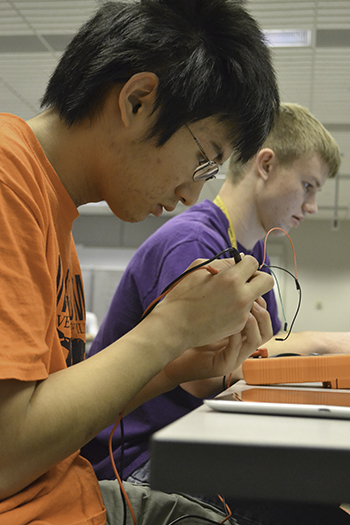
Two ENG 198 students work on their personal mobility project: bicycle gears that shift automatically.
The idea behind ENG 198, the new Engineering course being piloted in fall 2016, is to give freshmen a chance to discover what it’s like to be an engineer early on…with a few caveats. Working as part of an interdisciplinary team, students are to come up with an innovation of benefit to society in the area of personal mobility. Plus, despite the students being freshmen, course planners don't intend to smooth out the path for the students; they want the students to navigate some bumps in the road—just like real engineers do. The goal? For students to learn the engineering process, experience teamwork, and come up with an end product that—while not necessarily 100% successful—lets them experience having contributed to society.
Developed by MechSE Professor and POETS PI, Andrew Alleyne; IEFX Instructor Joe Bradley; and ECE Professor Emeritus, Phil Krein, the joint IEFX/POETS course is most likely similar to other projects courses: teams of 3–5 students have a budget of $200–300 and a timeline of 8–9 weeks to complete a project that is a useful innovation. However, the course has several components that separate it from Engineering’s other freshman project courses. For one, students' useful innovations are to be related to a specific theme: personal mobility.
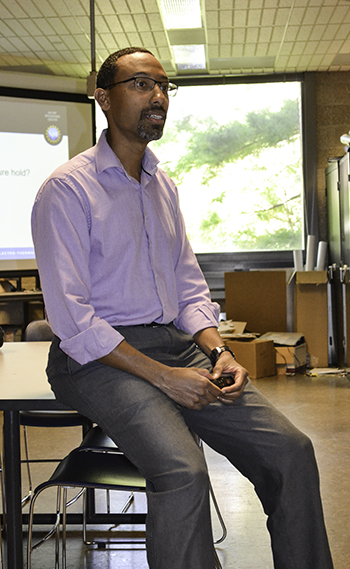
One of the creators of ENG 198, Andrew Alleyne, shares a session with the students about personal mobility and why it's an emerging area.
According to Alleyne: "One of the nice things is that you can actually affect a lot of lives through this personal mobility. A lot of people think about engineers as just sitting in front of a computer…the personal part about his means that you actually go out and try to affect somebody’s life to change it.
Bradley adds that they are giving students "a specific theme that targets specific needs in a growing demographic to help identify and shape the innovations that they might develop.”
Bradley, who teaches several iEFX projects courses, says Engineering is moving away from the idea of just building great technology and toward the model where what is built should benefit society. “Now we’re trying to turn that technology into innovation,” he explains. “The way we define innovation is that it has some utility, some usability...some need we are actually addressing.”
So the need ENG 198 is addressing is personal mobility. Exactly what is personal mobility? When addressing the class, Alleyne, defined it as: “Ever since humans have been around, personal mobility has always been a part of what we do. If you start off at point A, we’ve always had a need to get to point B for multiple reasons."
Reasons he and the class came up with include: self preservation/danger evasion; finding food/a favorable environment for food; health and wellness; recreation and exercise; societal opportunities (school, a job); social aspects, such as friends and/or relationships. During his talk, Alleyne also covered some of the myriad personal mobility devices man has come up with throughout history, ranging from chariots, to the bicycle, to the automobile.
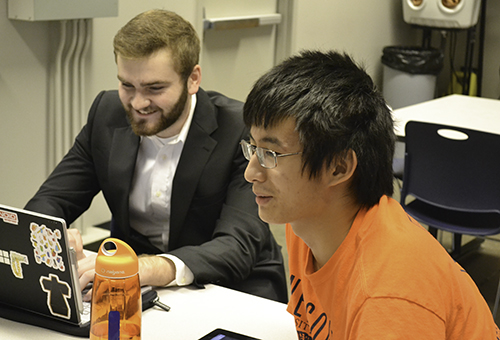
Two team members work on their project: Shifters (automatics bike gear shifting).
Despite the fact that it’s been around forever, personal mobility is currently trendy. It's the new buzzword among all the automobile manufacturers dabbling in it. How trendy? Detroit Auto Show Preview dubs it “the new black.”
Not only trendy, it’s significant among growing demographics: teenagers through baby boomers are concerned with it. It’s “a place which has a lot of potential for growth,” Bradley admits. “It’s a growing market, and there needs to be a lot of innovation in that space.”
The topic was also chosen because of its social implications. Course planners hope to study its impact on the students. “One of the goals was to understand how students worked on a more social problem,” says Bradley. “Does it have more intrinsic motivation, and do they feel more like engineers this early?”

An ENG 198 student at work on her team's personal mobility project:.
Bradley says projects courses often address “preset projects…taken out of a box.” But in this course, the project could potentially have future implications—be a problem for which answers need to be sought. Teams are tackling:
- Off-Road Wheel Chair – a wheel chair for challenging terrain
- PackDrop – portable backpack set and back rest
- Foldable Longboard – a skateboard that allows for easy storage and convenience
- Shifters – automatic bike gear shifting
Course planners also hope to see if exposing beginning engineers to things engineers in industry are currently working on might change their mindset :
“Now you are thinking about large-scale social issues early on. Does that have an impact on how you perceive yourself as an engineer? Do you perceive yourself as a humanitarian and not just a technician?”
Another component sets ENG 198 apart—its interdisciplinary emphasis. Most engineering classes are comprised of students in the same discipline, but that’s not how engineering is in the real world. So this course enrolls students from all engineering disciplines, to provide a richer experience for students.
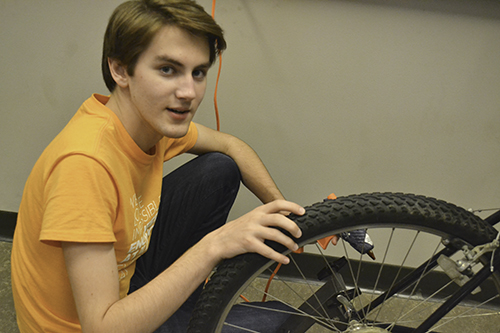
A member of the team that's tackling automatic bike gear shifting works on their bike.
“In practice, you won’t be in a room fool of mechanical, or a room full of electrical or civil,” says Bradley. “It’s an idea of understanding those different engineering groups, what information they need to be successful, and what information they can tell you to be successful. And what’s your part of the project? That’s an element we are trying to bring into this class even at this level; we want them to have an appreciation for what other disciplines bring into the project development space.”

An ENG 198 student uses a drill press as she works on her team's personal mobility project: a foldable longboard.
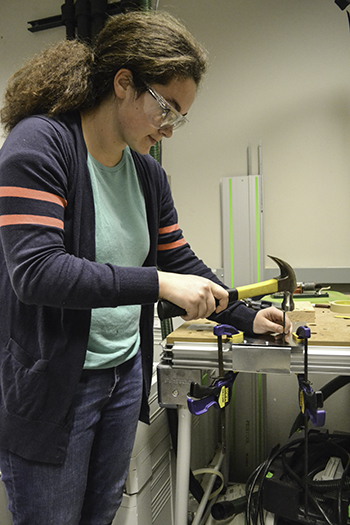
An ENG 198 student works on her team's personal mobility project.
Alleyne underscores why they chose to emphasize multidisciplinary collaboration:
"What we’re hoping to do through this IEFX program is give you a sense for how your engineering skills...are going to actually interweave with skills from multiple other fields, no matter what field you choose.
The idea is that students not only get used to working in interdisciplinary teams, but bring their own disciplinary strengths, thus generating products that are interdisciplinary in nature.
What kinds of projects did students select, and did they bite off more than they could chew? Possibly, but Bradley’s ok with that. “I’m the kind of person who promotes just the wild ideas. I really want them to push themselves to do something they didn’t think they could pull off. So they can work through the process.”
Alleyne would agree: "We want to spend a little bit of time talking about engineering and innovation, because you’re supposed to be coming up with ideas—crazy ideas, outside-the-box ideas!"
Given that wild, crazy ideas are being encouraged, and given that these are fledgling engineers, perfection isn't the goal. In fact, Bradley acknowledges that failure might occur:
“The goal isn’t that you will have a product that works 100%. The goal is that you go through the process of product development and product design, and teamwork, understand how to work in a team, and how to manage conflicts in a team so that you can get to the end goal.”
So how does one rein in the ambitious team whose project seeks to solve all of society’s ills before the end of the semester? Bradley says:
“They have these wild ideas, and then we take some portion of those ideas that they can demonstrate at the very end, and they feel like they’ve accomplished something. We don’t expect them to solve grand challenges within eight weeks, or even four years. We expect them to take an element of that project and say, ‘We might be able to present some proof of concept about this part of the solution.’”
Even more important than the end product, Bradley says they “hope that in the process they will learn the core objectives that the course is teaching.
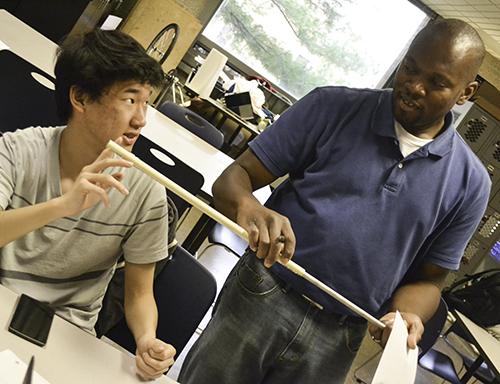
ENG 198 instructor Joe Bradley (right) works with a student on the PackDrop team.
"The core objectives are learning the project management process—taking your idea from a sketch on paper to an actual product or service— and teamwork, learning to work together as a team and to manage conflicts on a team while still being able to deliver. Also reflecting on the process; we want you to reflect on these experiences so you can learn from them throughout your engineering career,” he acknowledges.
Surprisingly, Bradley’s not horrified when conflict rears its ugly head. In this course, it’s a good thing, so that during this first stab at teams, students who disagree can learn conflict management.
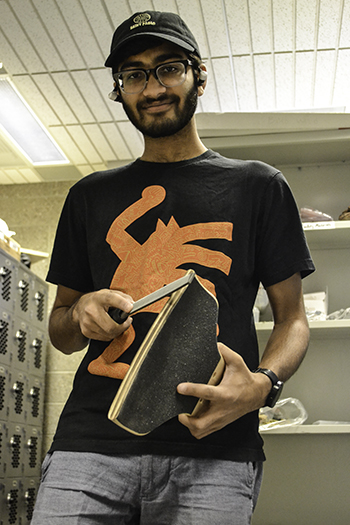
An ENG 198 student works on his team's foldable longboard.
“Yes, I’ve seen it in many different situations on teams. And they just have to go through the process of managing that.” So groups implemented a team charter, where students made a contract on how they planned to interact as a team. They decided when, where, and how long they were going to meet every week outside of class. They devised a system for making group decisions, or possibly elected a group leader.
“So it maps out how they will deal with these things,” admits Bradley. “We know you might have conflicts in the group, and this can be used as a common way to mitigate that.”
Also, there were no Lone Rangers in this course…nor deadbeats, because a responsibility matrix assigned each student a task. We’ve all experienced this dynamic on teams. One person who doesn’t trust others in the group to do a good job and does everything him or herself. Bradley’s seen it before. “In the past, I’ve seen that there might be one or two students who lead the project, but end up doing the entire project. “
So the task matrix helps this type of person to trust others, to embrace synergy—so everyone brings their strengths to the team: “I want those students to start trusting in the competence of students around them—in what they are able to do. Because you won’t be able to do everything. Being successful requires diversity of thought and approaching things in a different way, and you being a single person won’t know every way.”

A member of the team that's tackling automatic bike gear shifting works on their project.
Then there’s the slacker who doesn’t do his or her fair share but takes advantage of the group. Or the quiet student who tends to disappear. A task matrix forces them to step up and take responsibility. Bradley's matrix “gives everyone the responsibility of knowing that the team will trust and expect some competency from them. So that’s going to affect how you approach your studies and your work…you won’t be able to just sit there and do nothing since they expect something from you.”
Another difficulty course designers factored in is that the students are freshmen who, obviously, haven’t had a lot of engineering yet. The idea is to lay a foundation they can build on.
“We try to deliver some engineering principles…assignments where they can build those skills and reflect on what engineering concepts are in their projects. They might not the right terminology, but when they do take those classes, they can reflect on what they did here. Then by senior design time, these ideas are skills that are almost automatic. This kind of thinking, we hope to grow in their early stages.”
"Our goal," Bradley says, "is that students will gain perspective on the use and responsibilities for engineering in a wider space—primarily providing solutions to real problems and understanding people’s needs, working with people and not thinking they are just engineers who make technology, but people who understand how that tech is useful for actual people."
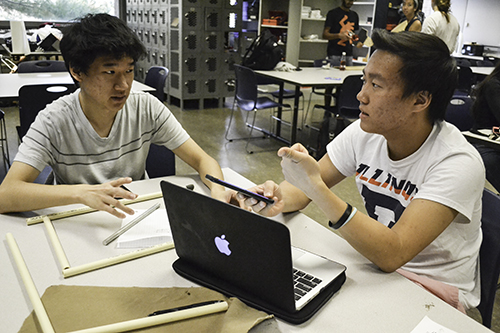
A member of the team that's tackling automatic bike gear shifting works on their project.
Also unique about ENG 198 is the interaction with industry folk. “Because it’s a new program,” admits Bradley, “we wanted to give them a real outside view...see if this is a kind of model that we can use later on in other first-year courses.”
So several industry leaders presented: Scott Daegle, CEO of Intelliwheels; Ken Taylor, director of Capitol One, focusing on Big Data; Jana Lynott of AARP regarding changing demographics, urban planning,and layout for personal mobility; and Caterpillar's Julian Sanchez about User-Centric Design: how to put the user at the middle of the design process to build designs that users want and can appreciate.
At the end of the semester, on December 6th, students will showcase their projects at an IEFX courses Expo. “We’ve seen that when students see their peers working on all these different kinds of things, it’s inspiring to them,” Bradley explains. “It inspires you to also contribute."
For additional I-STEM web articles about POETS, see:
- POETS Seeks to Change the Attitudes, Shape of Students in the STEM Pipeline
- POETS, New NSF Center at Illinois, Poised to Revolutionize Electro-Thermal Systems
Story and photos by Elizabeth Innes, Communications Specialist, I-STEM Education Initiative
More: Engineering, iEFX, POETS, Undergrad, 2016
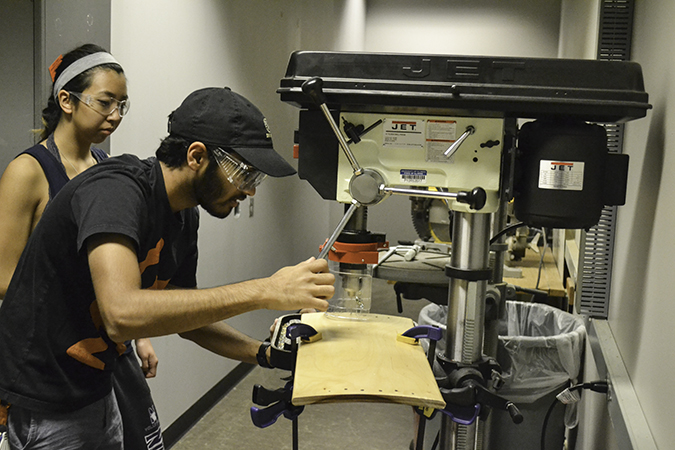
Two freshmen in ENG 198 use a drill press on their project, a foldable longboard (skateboard) to allow for easy storage and convenience.













.jpg)
















